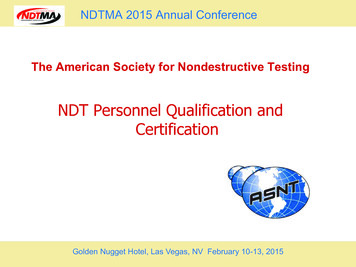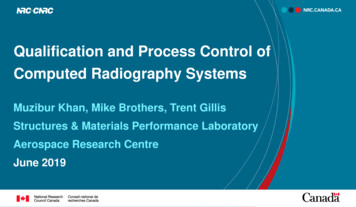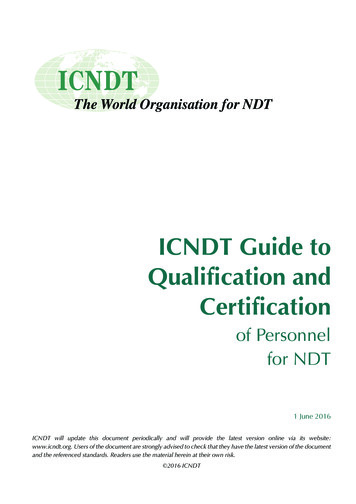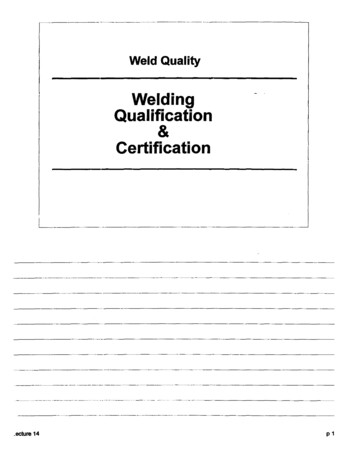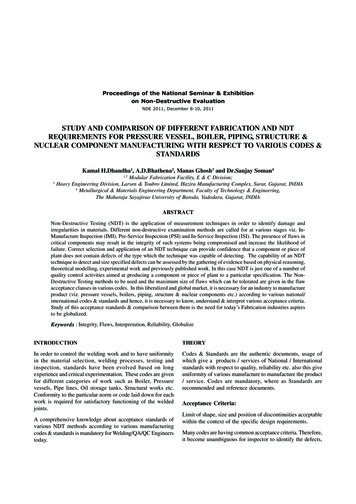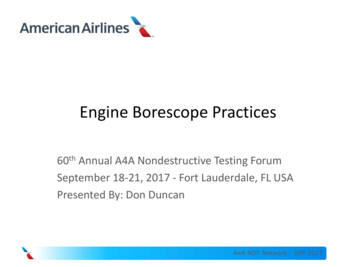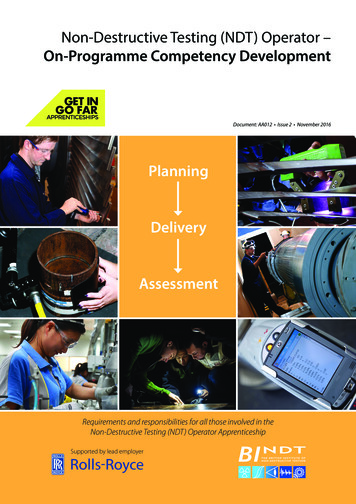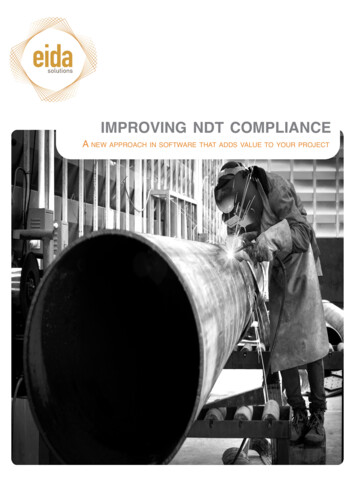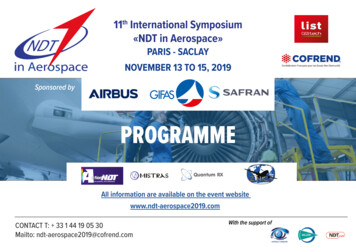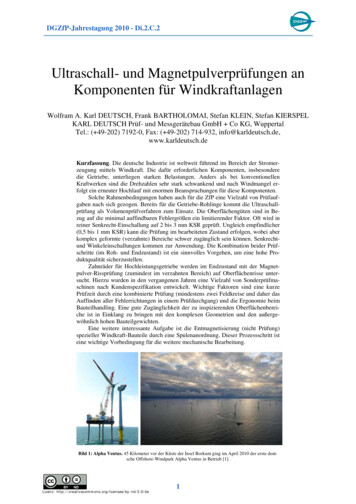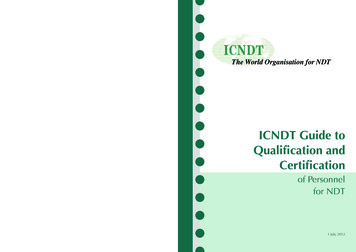
Transcription
ICNDT Guide toQualification andCertificationof Personnelfor NDTPublished on behalf of ICNDT by the Publishing Department, The British Institute of Non-Destructive Testing,Newton Building, St George’s Avenue, Northampton NN2 6JB, UK.Tel: 44 (0)1604 89 3811 Fax: 44 (0)1604 89 3861 Email: info@bindt.org Web: www.bindt.orgwww.icndt.org1 July 2012
ICNDT Guide toQualification andCertificationof Personnelfor NDT1 July 2012ICNDT will update this document periodically and will provide the latest version online via its website:www.icndt.org. Users of the document are strongly advised to check that they have the latest version of the documentand the referenced standards. Readers use the material herein at their own risk. 2012 ICNDT
2ICNDT GUIDE TO QUALIFICATION AND CERTIFICATIONOF PERSONNEL FOR NDTContentsFOREWORDS. 31. BACKGROUND. 42. RECOMMENDATIONS ON QUALIFICATION AND CERTIFICATION. 53. RESPONSIBILITIES OF THE EMPLOYER. 54. REQUIREMENTS FOR NDT PERSONNEL CERTIFICATION BODIES. 8APPENDICES. 9Appendix 1:The role of ICNDT and its regional groups in the harmonisation of qualificationand certification. 10Appendix 2:Bibliography. 14Appendix 3:Qualification and certification of NDT personnel in accordance with EN ISO 9712: 2012. 15Appendix 4:Qualification of NDT personnel in accordance with EN ISO 20807 and ISO TS 11774. 16Appendix 5:ASME position on recognition and acceptance of central certification programmes. 18Appendix 6:Non-destructive testing under the European Pressure Equipment Directive (97/23/EC). 20Appendix 7:Basic principles of NDT. 21Appendix 11: Code of practice for personnel certification bodies. 28Appendix 12: ICNDT membership directory. 28
ICNDT GUIDE TO QUALIFICATION AND CERTIFICATIONOF PERSONNEL FOR NDTForeword by Chairman of ICNDTThe competence of those carrying out non-destructive testing is an essential pre-requisite for the achievement ofquality and reliability. Qualification and certification of NDT personnel in accordance with international standardssuch as the unified EN ISO 9712 (Non-destructive testing – Qualification and certification of personnel) helps toassure the competence of NDT personnel and thereby assists global business and safety standards.The ICNDT, with a track record exceeding 50 years in international cooperation in NDT, is dedicated to supportingbest practice in the implementation of standards through this Guide. As Chairman, I express thanks to my colleaguesin ICNDT, ISO and CEN for their assistance in preparing this document.Mike FarleyChairman, ICNDTForeword by Chairmen of ISO TC135 and CEN TC138Since the effectiveness of any application of non-destructive testing depends upon the capabilities of the personswho perform or who are responsible for the test, a procedure was developed to provide a means for evaluating anddocumenting the competence of personnel whose duties require the appropriate theoretical and practical knowledgeof the non-destructive tests that they perform, specify, supervise, monitor or evaluate. An added incentive stems fromthe worldwide comparability of a wide range of industrial applications requiring common non-destructive testingapproaches.It is recognised that the efforts of ICNDT have made a valuable contribution to the implementation of the numerousschemes for qualification and certification of NDT personnel. An extensive application of this Guide within industrywill improve reliability of industrial products and safety of the worldwide community.Hajime HatanoISO TC135 ChairmanPatrick FalloueyCEN TC138 ChairmanForeword by Chairman of the PGP and Editorial CommitteeThe original Guide, ‘ICNDT Recommended Guidelines for Qualification and Certification of NDT Personnel accordingto ISO 9712’, was published in June 2004 at the 16th WCNDT in Montreal, based on a first draft produced byMr G Nardoni. The first update was approved for publication at the 17th WCNDT in Shanghai. This version is publishedto coincide with the 18th WCNDT in Durban and the agreements in ISO and CEN to unify ISO 9712 and EN 473in a new standard EN ISO 9712, to be published in 2012, and the developments underway in ICNDT to create aninternational Multilateral Recognition Agreement.ICNDT will update this document periodically and will provide the latest version online via its website (www.icndt.org). Users are strongly advised to check that they have the latest version of this document and the referencedstandards. Comments and suggestions are welcome and should be sent to the ICNDT secretariat.Douglas MarshallChairman PGP and Editorial Committee3
4ICNDT GUIDE TO QUALIFICATION AND CERTIFICATIONOF PERSONNEL FOR NDT1. BackgroundThe prime purpose of this Guide, which has been prepared under the auspices of the International Committee forNon-Destructive Testing (ICNDT), is to promote best practice in the qualification and certification of NDT personnelaccording to the international standard EN ISO 9712.The competence of NDT personnel is a key element in achieving reliability in non-destructive testing (NDT) and isvital to ensure the quality and safety of products and installations. The ICNDT Guide is of importance to all tiers in themanagement of NDT operations: regulators, inspection bodies, certification bodies, industry, NDT service companiesand supervisors of NDT personnel.The ICNDT has promoted worldwide dissemination of NDT technologies and the harmonisation of personnelcertification schemes for more than 45 years. The decision by ICNDT to promote the adoption of EN ISO 9712 asa basic standard for third-party qualification and certification of NDT personnel arises from the need to achieve amore consistent standard of basic knowledge and practical competence. Such standardisation becomes ever moreimportant as the globalisation of trade increases.Third-party qualification and certification is widely recognised as conferring a number of advantages:l It complies with an internationally agreed ISO standard that is increasingly being adopted worldwide;l It utilises an internationally developed training syllabus;l Examinations (theory and practical) are provided directly by certification bodies or through authorised qualifyingbodies and authorised examination centres under the control of certification bodies (many of which are linked tonational NDT societies);l It provides a harmonised standard for training, qualification and certification of NDT personnel and can be used as thebase level for more specific employer-based or third-party certification relevant to particular products or installations.ISO 9712: 2005 (the third edition) gives more detailed requirements for practical examinations (including details of practicalexamination specimens and their defect content) to determine the practical ability of the candidate, to better harmonisepractical examinations and to provide guidance on the definition of industrial and product sectors to aid internationalharmonisation. Further harmonisation is possible by using the ISO/TR 25107 ‘Guidelines for Training Syllabuses’.The central role of EN ISO 9712 among standards for third-party certification, the historical development of NDTpersonnel certification and ICNDT’s role is explained within this Guide.Correct use of third-party qualification and certification of NDT personnel is dependent on the employers’ recognitionof responsibility for NDT personnel. This is important in terms of good quality management practices (outlined inISO 9001: 2008 at clause 6.2 – Human Resources), product liability, meeting the requirements for accreditation andmeeting the requirements of product standards and codes, such as the ASME Boiler and Pressure Vessel Code andthe European Pressure Equipment Directive (97/23/EC). An explanation of the employer’s responsibilities is provided.In each of the regions where ICNDT has members (Africa, the Americas, Europe, the Middle East and the Asia-Pacificregion), ISO 9712 has been adopted as a basis for third-party certification schemes. For example, Brazil and Argentinahave accredited certification schemes which comply with ISO 9712 and Canada also has a certification scheme basedon the standard. In the USA, the American Society for Nondestructive Testing (ASNT) has introduced ANSI/ASNTstandard CP 106, which is closely aligned with ISO 9712. Many other countries in Latin America: Uruguay, Peru,Bolivia, Colombia and Venezuela, are developing national schemes based on ISO 9712. In the Asia-Pacific region,Australia, Japan and China, among many other countries, have introduced schemes based on ISO 9712. In Europe, alarge number of countries have schemes which comply with EN ISO 9712. A listing of certification schemes and theircurrent status is provided.The ICNDT is endeavouring to promote international recognition of third-party certification schemes through a globalMultilateral Recognition Agreement (MRA) and details are given. In many countries around the world, certificationbodies that provide EN ISO 9712 certification have gained accreditation or approval by government agencies oraccreditation bodies in both voluntary and regulatory sectors. This is discussed later in the Guide.Details of other approaches to NDT personnel certification can be referenced at www.efndt.org (for aerospacecertification to EN 4179) and www.asnt.org (for in-company certification to SNT-TC-1A).
ICNDT GUIDE TO QUALIFICATION AND CERTIFICATIONOF PERSONNEL FOR NDT2. Recommendations on qualification and certificationRecommendations to users of central third-party certificationWhen central third-party certification is appropriate, it is recommended that regulators and industry define the levelsof competency of NDT personnel who are certified in accordance with EN ISO 9712 by a certification body accreditedto ISO IEC 17024.Regulators, users and auditors of NDT operations should recognise the importance of employers of NDT personnelproperly fulfilling their responsibilities to authorise personnel to work after first confirming that their employees areadequately trained, experienced and qualified.Recommendations to certification bodiesCertification bodies are urged to provide certification to EN ISO 9712 in order to maximise the value of theircertification. In anticipation of future harmonisation, their training syllabuses should encompass the requirements ofISO/TR 25107.Recommendations to national standards bodiesIn adopting the international standard EN ISO 9712, the ISO member body is strongly urged to apply it withoutdeviation from the original text in order to ensure that it acts as a harmonising influence. Failure to do so could resultin a refusal to recognise or accept NDT personnel certification issued by certification bodies operating to nationalstandards with deviations created under ISO guide 21.3. Responsibilities of the employerAn employer of NDT personnel carries important responsibilities for the overall quality of NDT operations. Theseshould be reflected in the employer’s quality procedure for NDT (which may be known as the written practice1).The employer retains these responsibilities whether he uses in-company certification, third-party certification or acombination of both.This section of the ICNDT Guide clarifies the employer’s responsibilities within the framework of using personnelqualified to EN ISO 9712 and gives guidance on how the employer should fulfil these responsibilities. In this context,the employer (or responsible agency) is defined as ‘the organisation for which the candidate works on a regular basis’.If the individual is self-employed, he shall assume all responsibilities specified for the employer or responsible agency.It is a central tenet of the standard that the employer has overall responsibility for the results of NDT operations and isfully responsible for the authorisation of his staff to work. In practice, this must include checking that the NDT tasksto be carried out are within the scope of the individual’s certification (sector, method and level) and, if they are not,organising additional job-specific training and/or examinations (see Figure 1).The employer is responsible for introducing candidates to the certification body and for documenting the candidate’seducation and prior experience. (If the candidate is unemployed or self-employed, the declaration of education,training and experience shall be attested to by at least one independent party.)The employer must ensure annually that employees meet the visual acuity requirements of the certification body andmust keep records of work experience that will be needed to demonstrate continuity of satisfactory work activity withoutsignificant interruption. This is important both for his own quality assurance an
management of NDT operations: regulators, inspection bodies, certification bodies, industry, NDT service companies and supervisors of NDT personnel. The ICNDT has promoted worldwide dissemination of NDT technologies and the harmonisation of personnel certification schemes for more than 45 years. The decision by ICNDT to promote the adoption of EN ISO 9712 as
